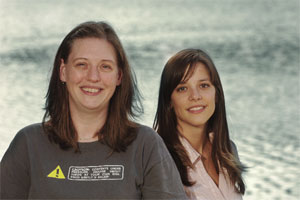 |
| The research of PhD student Angelia Vanderlaan and masters student Kim Davies is leading to changes in the Roseway Basin. (Danny Abriel photo) |
There are less than 400 of them left in the world, and many of them travel to Canadian waters each year to feed. The North Atlantic Right Whale is one of the most endangered whales in the world.
Now, research by HÂþ» student Angelia Vanderlaan and Oceanography professor Christopher Taggart is helping ensure these whales are protected from vessel strikes when they make their annual trek to the Roseway Basin on the Scotian Shelf.
Last week, Transport Canada announced that a proposal submitted by the federal government to protect these whales has been adopted by the International Marine Organization (IMO).
|
"We pulled together numbers to try to determine the relative probability of ships striking whales," says Ms. Vanderlaan. "That information was used to design the ATBA so that the risk of a collision was minimized."
Right whales are especially vulnerable to being struck by vessels, due to their behaviours and characteristics. They are black in colour, with no dorsal fin, making them hard to see. The whales also spend extended periods of time near the surface of the water and tend to be especially slow to respond to approaching vessels, if at all.
Ms. Vanderlaan says the best part about doing research like this is to see the 'real-world' results. "Through similar types of analyses, we were able to help move shipping lanes in the Bay of Fundy. It's very gratifying to know that the work you are doing is making a difference."
"The quantitative analysis itself is fun, but what's really pleasing is actually being able to have an impact on critical habitat issues," says Dr. Taggart. "The research makes a difference in how we deal with these and other conservation issues."
Their research is having an international as well as local impact. The paper, "Vessel Collisions with Whales: The Probability of Lethal Injury Based on Vessel Speed," by Ms. Vanderlaan and Dr. Taggart, was published in Marine Mammal Science earlier this year and is being cited in a court case in Hawaii concerning a high-speed ferry and potential humpback whale strikes. Their work is also being used to mediate a dispute between the National Oceanic and Atmospheric Administration (NOAA) and the White House regarding vessel speed in certain areas of the American east coast.
"It's interesting times for us," says Dr. Taggart, also noting the work of first-year Masters of Oceanography student Kim Davies.
Kim is working in collaboration with the Department of Fisheries and Oceans on a project to address feeding conditions for the right whale in Roseway Basin area – another important issue concerning right whale population recovery.

